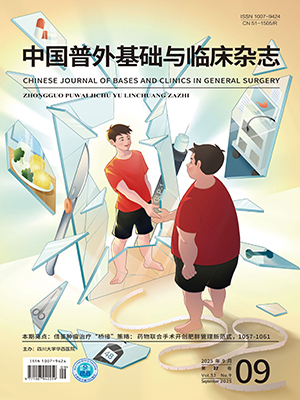| 1. |
鲍淑梅, 张亚杰, 田丰. 炎症性肠病合并结直肠癌的流行病学和防治进展. 中国临床医生杂志, 2021, 49(12): 1409-1413.
|
| 2. |
Pantalos G, Patsouras D, Spartalis E, et al. Three-dimensional versus two-dimensional laparoscopic surgery for colorectal cancer: systematic review and meta-analysis. In Vivo, 2020, 34(1): 11-21.
|
| 3. |
Kojima Y, Sakamoto K, Okuzawa A. Experience of using a spray-type anti-adhesion barrier in laparoscopic surgery for colorectal cancer. J Surg Case Rep, 2019, 2019(3): rjz085. doi: 10.1093/jscr/rjz085.
|
| 4. |
Tsuruta M, Hasegawa H, Okabayashi Koji, et al. Needlescopic versus conventional laparoscopic surgery for colorectal cancer: a comparative study. J Anus Rectum Colon, 201, 1(2): 45-49.
|
| 5. |
姜卫生, 张振豪, 汪长青, 等. 减孔腹腔镜手术治疗对结直肠癌患者免疫功能、氧化应激反应的影响. 中国临床医生杂志, 2022, 50(4): 450-452.
|
| 6. |
崔宇, 沈贵虎, 王浩. 腹腔镜结直肠癌根治术对结直肠癌患者氧化应激及能量代谢的影响. 贵州医药, 2020, 44(10): 1546-1547.
|
| 7. |
中华人民共和国国家卫生和计划生育委员会医政医管局, 中华医学会肿瘤学分会. 结直肠癌诊疗规范(2015年版). 肿瘤综合治疗电子杂志, 2017, 3(1): 6-24.
|
| 8. |
高明, 周华, 朱研, 等. 间接测热法与预测公式对肝脏术后患者能量消耗评估的差异性分析. 临床急诊杂志, 2021, 22(1): 42-45.
|
| 9. |
Zanella PB, Avila CC, Souza C. Estimating resting energy expenditure by different methods as compared with indirect calorimetry for patients with pulmonary hypertension. Nutr Clin Pract, 2018, 33(2): 217-223.
|
| 10. |
Fukuoka E, Matsuda T, Hasegawa H, et al. Laparoscopic vs open surgery for colorectal cancer patients with high American Society of Anesthesiologists classes. Asian J Endosc Surg, 2020, 13(3): 336-342.
|
| 11. |
Brierley JD, Gospodarowicz MK, Wittekind C. TNM classification of malignant tumours. John Wiley & Sons, Hoboken, NJ, USA: 2017: 8-9.
|
| 12. |
Wada Y, Miyoshi N, Fujino S, et al. New marking method involving a light-emitting diode and power source device to localize gastrointestinal cancer in laparoscopic surgery. Sci Rep, 2019, 9(1): 5485. doi: 10.1038/s41598-019-41981-w.
|
| 13. |
Duque P, Garutti I, Terradillos E, et al. Modulation of CCL2 expression by laparoscopic versus open surgery for colorectal cancer surgery. Surg Laparosc Endosc Percutan Tech, 2019, 29(2): 101-108.
|
| 14. |
孔令永, 陈雷, 陈焰, 等. 腹腔镜下保留左结肠血管手术治疗中低位直肠癌效果及安全性. 临床军医杂志, 2021, 49(12): 1383-1388.
|
| 15. |
周志涛, 郭磊, 王峰. 腹腔镜直肠全系膜切除术对低位直肠癌患者氧化应激、能量代谢及预后的影响. 中国医学前沿杂志(电子版), 2020, 12(9): 129-133.
|
| 16. |
Siddiqui J, Young CJ. Thirteen-year experience with hand-assisted laparoscopic surgery in colorectal patients. ANZ J Surg, 2020, 90(2): 113-118.
|
| 17. |
Mascherini G, Ringressi MN, Castizo-Olier J, et al. Preliminary results of an exercise program after laparoscopic resective colorectal cancer surgery in non-metastatic adenocarcinoma: a pilot study of a randomized control trial. Medicina (Kaunas), 2020, 56(2): 78. doi: 10.3390/medicina56020078.
|
| 18. |
杨阳, 宋红霞, 陶连元, 等. 急性胰腺炎患者间接测热法和公式预估法计算每日总能量消耗的比较. 中华肝胆外科杂志, 2021, 27(9): 676-680.
|
| 19. |
黄宝玉, 田景中, 李光云, 等. 腹腔镜与开腹式结直肠癌根治术对细胞免疫和氧化应激及能量代谢的影响. 中国医药, 2021, 16(9): 1365-1368.
|
| 20. |
何利, 何茂梁, 袁波, 等. 腹腔镜手术治疗对结直肠癌患者血清炎性因子、VEGF、MMP-9、氧化应激及免疫功能的影响. 海南医学院学报, 2017, 23(18): 2546-2549.
|




